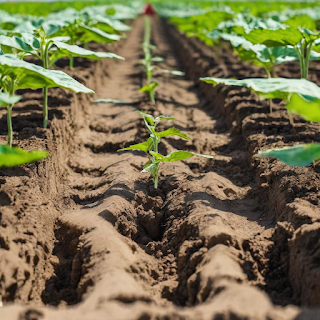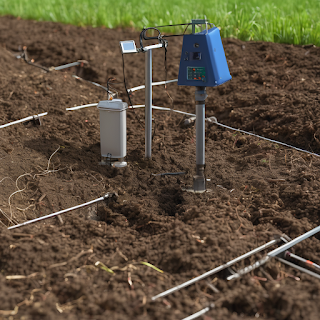While issues like erosion, compaction and nutrient deficiencies typically garner attention in discussions around soil health, a less visible yet equally problematic constraint exists—salinity. Excess soluble salts accumulating in root zones pose a significant yet often overlooked threat to crop productivity and yield stability on irrigated lands worldwide.
Salinity impairs plant water relations and ion balance, limiting yields substantially when concentrations breach tolerance thresholds of specific crops. Fortunately, novel precision techniques now enable identification and remediation of problematic zones before visible impacts occur.
Chief among emerging strategies, soil electrical conductivity (EC) mapping harnesses cutting-edge sensor technology to detect and monitor subsurface salt levels with unprecedented accuracy. When paired with variable-rate irrigation and drainage, EC mapping holds promise as a proactive approach maximizing yields sustainably through precision salinity management.
The Invisible Threat of Salinity in Soil
While essential for life in small amounts, excessive soluble salts like sodium, chloride and sulfate ions accumulating in root zones pose a stealthy constraint to agriculture. Sources include poor quality irrigation water, high water tables, inadequate leaching from rainfall or irrigation, and dissolution of native salts from subsoil parent materials. Salinity impairs plant water potential and ion balance, with effects ranging from mild stress to complete crop failure as EC levels escalate past tolerance thresholds.
Notably, salts disperse unevenly via complex hydrologic patterns, concentrating in low-lying zones where impacts often go undetected until visible damage appears, costing growers significant yield penalties. While genetic improvements have lifted tolerances for some crops, precision techniques now enable proactive identification and remediation of problem areas before losses occur.
The Power and Promise of EC Mapping for Soil
EC mapping harnesses sensor-equipped platforms like tractors, ATVs or drones to detect subtle variations in soil electrical conductivity with unprecedented resolution. Georeferenced EC measurements, when combined with elevation data, reveal intricate subsurface salt dispersion patterns across entire fields. Some key advantages of this cutting-edge approach include:
- Noninvasive detection of salts to depths of 1 meter without disturbing soils.
- High-resolution mapping (1-5 meter grids) locates micro-zones requiring remediation before impacts appear.
- Identification of problematic low-lying drainage-impaired areas often overlooked with traditional sampling.
- Multi-year datasets enable monitoring of salinity fluctuations and tracking impacts of management strategies over time.
- Integration with variable-rate irrigation/drainage prescribes precise water/nutrient applications tailored to unique salt tolerances.
When paired with strategic reclamation practices, EC mapping holds promise as a proactive, precision solution maximizing yields sustainably through early salinity detection and targeted remediation.
On-Farm Trials on EC Mapping for Salinity Management
Several innovative growers partnering with land grant researchers have documented successes managing salinity risks through EC mapping:
- A vegetable operation in California avoided $30,000 in losses by reclaiming two problem zones identified through EC mapping before damage appeared. Yields matched non-saline areas after drainage improvements.
- A cotton farm in Australia increased yields 15-30% across 120 ha of marginally saline land through targeted gypsum and leaching guided by EC maps, recouping investment within two seasons.
- A tree fruit orchard in Chile mitigated yield losses from a problematic seep, maintaining production volumes through a variable rate leaching regimen prescribed from EC data.
Notably, these farms proactively optimized yields through precision salinity management versus costly trial-and-error, demonstrating EC mapping’s potential to safeguard profits sustainably when integrated strategically.
Optimizing EC Mapping on Your Farm
To fully leverage benefits, EC mapping programs should be carefully tailored based on soil properties, irrigation source, and specific challenges:
- Establish baseline maps and periodically resample to monitor impacts of drainage/leaching strategies.
- Adjust sensor depth and grid resolution based on salt dispersion patterns and intended management zone size.
- Consider elevation data to identify low-lying drainage-impaired areas requiring targeted improvements.
- Pair with soil sampling to ground-truth EC readings, calibrating maps for accurate interpretation.
- Strategically time sampling around irrigation/rainfall to capture peak salt concentrations.
- Integrate variable-rate technologies like precision irrigation/fertigation to differentially manage mapped zones.
With careful optimization, EC mapping shows strong potential to proactively safeguard yields from hidden salinity threats through precision detection and targeted remediation strategies.
Maximizing Benefits of Soil EC Mapping through Holistic Systems
To fully harness EC mapping’s power, an integrated “systems” approach maximizes synergies:
- Rotate crops based on salinity tolerances, exploiting natural remediation through phytoremediation.
- Consider controlled drainage systems and subsurface drip to differentially leach problem zones.
- Incorporate cover crops during fallow to scavenge and redistribute salts via phytoremediation.
- Utilize gypsum or other soil amendments strategically based on mapped zones’ specific issues.
- Blend surface and subsurface drainage improvements tailored to micro-topography.
- Monitor irrigation water quality and consider filtration/desalination to control inputs proactively.
A whole-farm perspective views salinity management as an integrated process. With careful multi-year implementation, these coordinated strategies can transform problem zones, safeguarding yields sustainably through precision techniques.
 |
| Healthy Soil, Healthy Plant |
Conclusions
In closing, salinity poses a significant yet stealthy threat to global agricultural productivity and sustainability that often goes undetected until damage appears. EC mapping represents an exciting breakthrough enabling proactive identification and targeted remediation of problematic zones before losses occur.
Exciting opportunities also lie on the research frontiers, such as sensor miniaturization allowing drone-based ultra-high resolution detection, statistical and machine learning techniques to streamline map interpretation, and precision-ag technologies advancing differential reclamation.
Overall, an integrated “systems” approach valuing EC mapping lays the foundation for sustainable intensification through precision salinity management well into the future.

Post a Comment